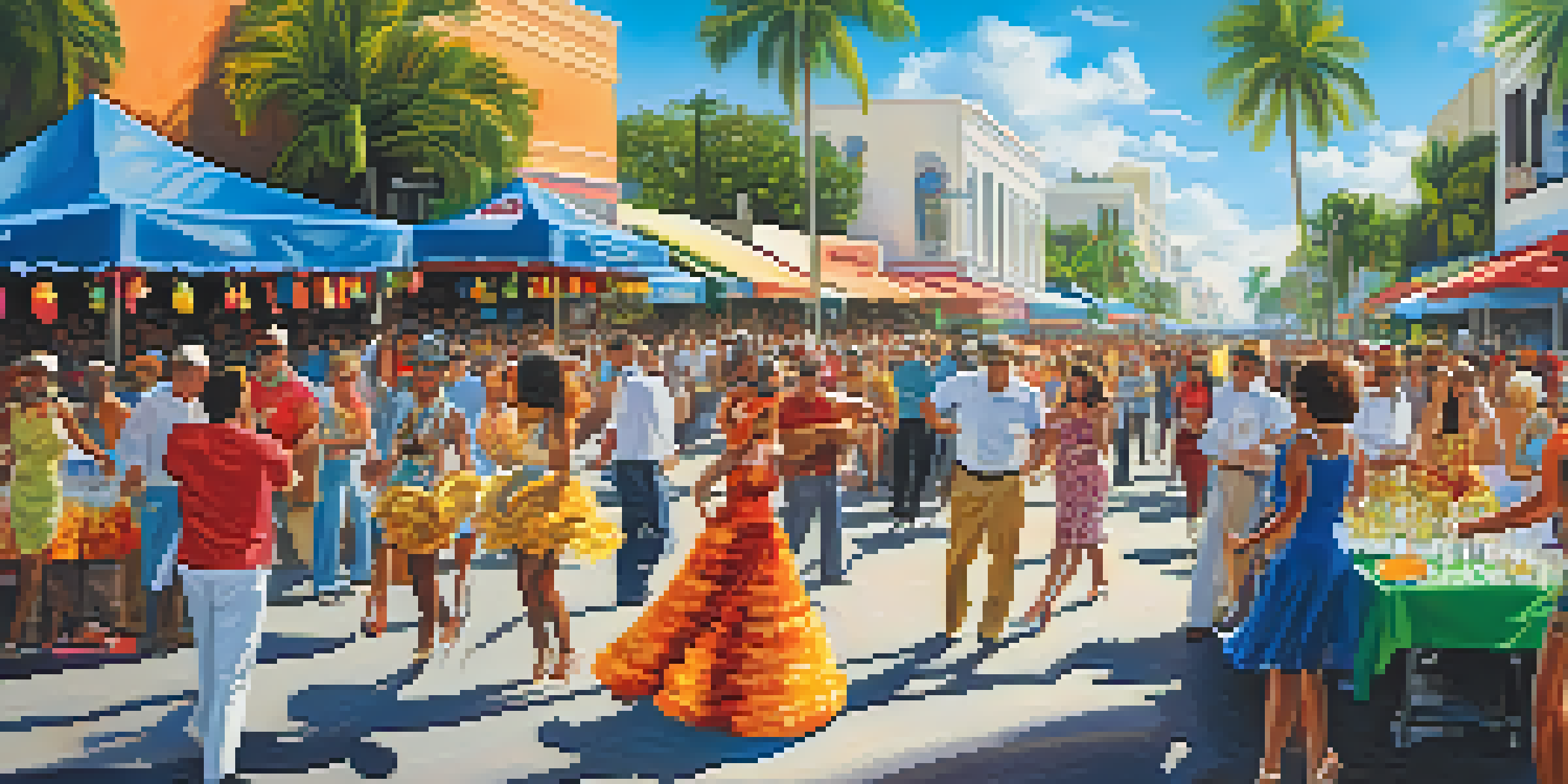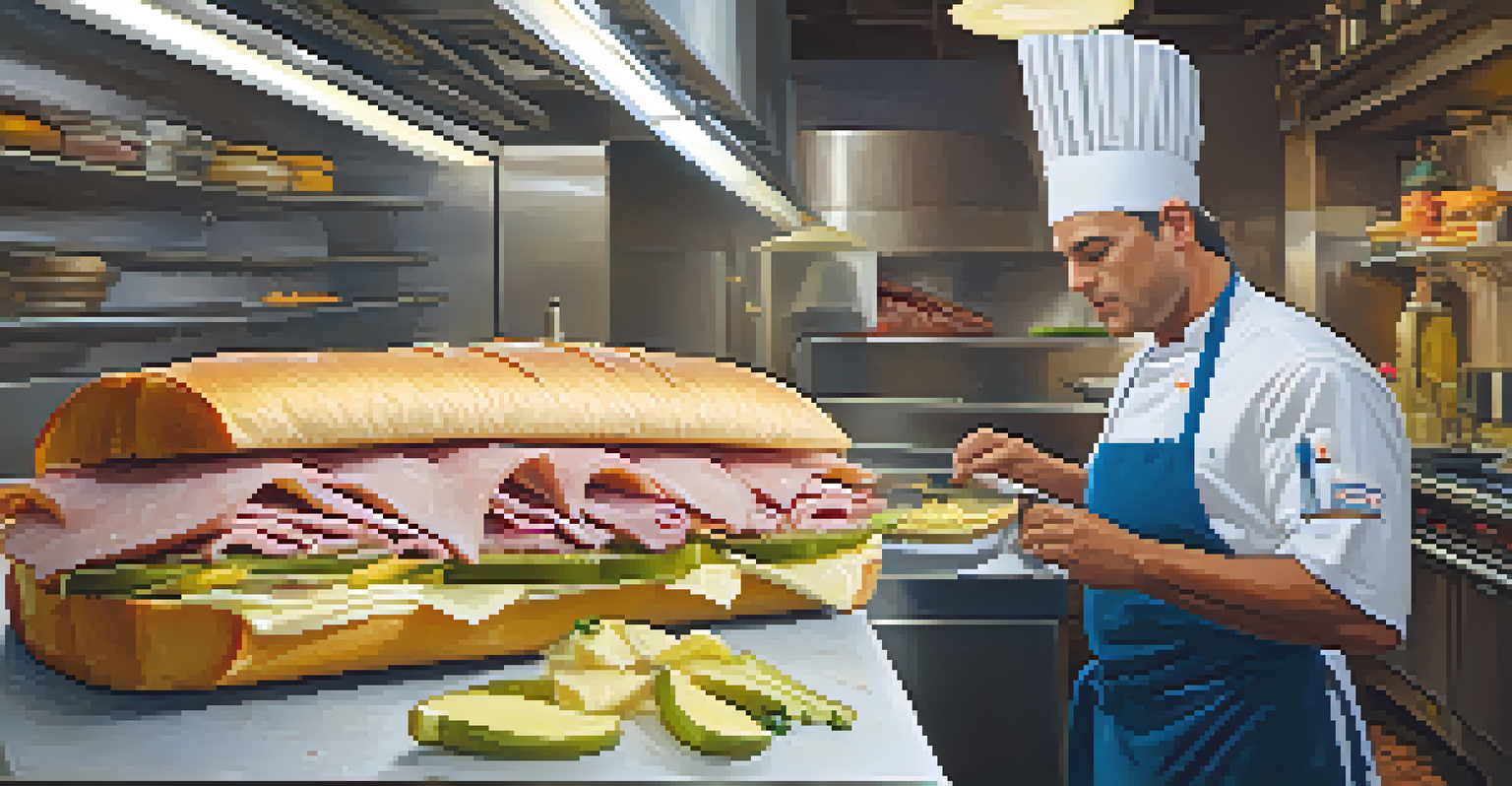Impact of Cuban Immigration on Florida's Cultural Landscape

Historical Context of Cuban Immigration to Florida
Cuban immigration to Florida has roots that stretch back to the late 19th century, particularly during the struggles for independence from Spanish rule. The most significant waves occurred after the 1959 Cuban Revolution, which led many to flee the new communist regime. This influx of immigrants transformed Florida, especially in cities like Miami, becoming a prominent hub for Cuban culture.
Cuban culture is as rich and diverse as the colors of its flag, and it has painted Florida with its vibrant hues for decades.
The Mariel Boatlift in 1980 marked another critical point in this history, bringing thousands of Cubans to Florida in a matter of months. These events not only changed the demographic landscape but also introduced a variety of cultural influences that are still evident today. Understanding this historical context helps us appreciate the rich tapestry of Florida's current cultural identity.
As Cuba and its political climate have evolved, so too has the nature of immigration. Today, new generations of Cuban Americans continue to arrive, each bringing unique perspectives and experiences that enrich Florida's diverse culture. This ongoing relationship between Cuba and Florida is a testament to the enduring impact of immigration.
Cuban Influence on Florida's Culinary Scene
One of the most delicious aspects of Cuban immigration is its profound impact on Florida's culinary landscape. Cuban cuisine, with its vibrant flavors and unique dishes, has become a staple in Florida, particularly in Miami. From classic dishes like Ropa Vieja to the ever-popular Cuban sandwich, these culinary delights have found their way into the hearts and stomachs of Floridians.

Restaurants and food trucks serving authentic Cuban food are now commonplace, drawing locals and tourists alike. This culinary fusion has also led to creative innovations, where traditional Cuban recipes are blended with other cultural influences. These culinary intersections not only celebrate Cuban heritage but also foster a sense of community among diverse populations.
Cuban Immigration Shapes Florida's Culture
The waves of Cuban immigration have significantly transformed Florida's cultural landscape, particularly in cities like Miami, blending vibrant traditions and influences.
Food festivals and cultural events frequently showcase Cuban cuisine, further solidifying its place in Florida's food culture. As more people discover and appreciate these flavors, the culinary influence of Cuban immigrants continues to grow, making it an integral part of Florida's identity.
Artistic Expressions of Cuban Heritage in Florida
Cuban immigrants have significantly contributed to Florida's artistic landscape through music, dance, and visual arts. From the lively rhythms of salsa and son to the soulful sounds of bolero, these musical genres have become synonymous with Florida's cultural identity. Venues showcasing live Cuban music are popular, providing spaces for both local and visiting artists to share their talents.
We’re not just immigrants; we are contributors to the fabric of American life, bringing our traditions, flavors, and dreams.
In addition to music, dance forms like salsa and mambo have flourished in Florida, creating vibrant communities centered around dance and celebration. These art forms not only express the Cuban spirit but also invite people from various backgrounds to join in, fostering a sense of unity through rhythm and movement. Events like street festivals often highlight these artistic expressions, drawing large crowds who come to dance and enjoy.
Visual arts also play a vital role in portraying Cuban heritage, with many artists drawing inspiration from their roots. Galleries and exhibitions frequently feature works that reflect the Cuban experience, adding depth and color to Florida's cultural scene. This artistic dialogue between Cuban and Floridian cultures enriches the state’s creative landscape, making it a lively hub for artistic expression.
Cuban Contributions to Florida's Economy
Cuban immigrants have made substantial contributions to Florida's economy, particularly through entrepreneurship and small business development. Many Cuban Americans have opened restaurants, shops, and professional services, creating jobs and stimulating local economies. This entrepreneurial spirit has not only bolstered Florida's economic growth but also enriched its cultural landscape.
The establishment of Little Havana in Miami stands as a testament to the economic impact of Cuban immigrants. This vibrant neighborhood is home to numerous businesses that celebrate Cuban culture, serving as both a cultural landmark and an economic engine. Such areas attract tourists, supporting the hospitality and tourism sectors significantly.
Cuban Cuisine Enriches Local Dining
Cuban cuisine has become a staple in Florida, with dishes like Ropa Vieja and Cuban sandwiches captivating both locals and tourists alike.
Furthermore, the contributions of Cuban immigrants extend beyond small businesses. Their involvement in various industries, from healthcare to technology, showcases the diverse skills and talents that enrich Florida's workforce. This blend of cultures and economic contributions creates a dynamic environment that propels Florida forward.
Cuban Community Organizations and Their Role
Cuban immigrants in Florida have established numerous community organizations that serve as vital support systems. These organizations provide resources for newcomers, helping them navigate their new environment while preserving their cultural identity. From legal assistance to language classes, these groups play a crucial role in the integration process.
Events organized by these community groups, such as cultural festivals and educational workshops, foster a sense of belonging among Cuban Americans. They also promote Cuban culture to the broader Florida community, encouraging cross-cultural understanding. This exchange enriches the social fabric of Florida, highlighting the importance of diverse perspectives.
Moreover, these organizations often engage in advocacy, addressing issues that affect the Cuban community and promoting policies that support their needs. Their efforts help ensure that the voices of Cuban Americans are heard, contributing to Florida's dynamic cultural and political landscape.
Challenges Faced by Cuban Immigrants in Florida
Despite their significant contributions, Cuban immigrants in Florida face numerous challenges, including economic disparities and social integration issues. Many newcomers encounter difficulties in finding stable employment or affordable housing, which can hinder their ability to thrive. These obstacles can create barriers to full participation in Florida's vibrant cultural and economic life.
Additionally, the complexities of immigration policies and changing regulations add another layer of uncertainty for Cuban immigrants. Navigating these bureaucratic hurdles can be daunting, often leaving families in precarious situations. This struggle to adapt can lead to feelings of isolation within the community, emphasizing the need for supportive networks.
Community Support for Cuban Immigrants
Cuban community organizations play a crucial role in supporting newcomers by providing resources and fostering cultural identity in Florida.
Efforts to address these challenges are ongoing, with community organizations and local governments working to provide resources and support. By raising awareness of these issues, Floridians can foster a more inclusive environment that celebrates the contributions of Cuban immigrants while addressing the barriers they face.
The Future of Cuban Culture in Florida
Looking ahead, the future of Cuban culture in Florida appears vibrant and promising. As new generations of Cuban Americans emerge, they continue to shape and redefine what it means to be part of this rich cultural heritage. This evolution ensures that Cuban traditions remain relevant, blending seamlessly with the influences of a diverse society.
Cultural events, festivals, and educational initiatives play a crucial role in preserving Cuban heritage while inviting others to participate. By promoting understanding and appreciation of Cuban culture, Florida can continue to celebrate its multicultural identity. This cultural exchange not only enriches the state but also strengthens community ties among Floridians of all backgrounds.

As we move forward, the influence of Cuban immigrants will likely continue to grow, further shaping Florida's cultural landscape. Embracing this diversity allows Florida to thrive as a melting pot of traditions, ideas, and experiences that reflect the dynamic nature of its population.